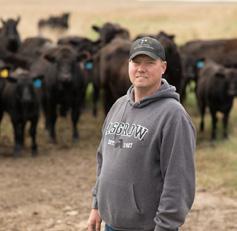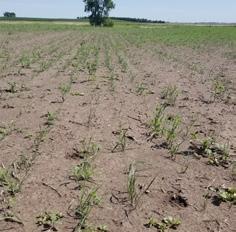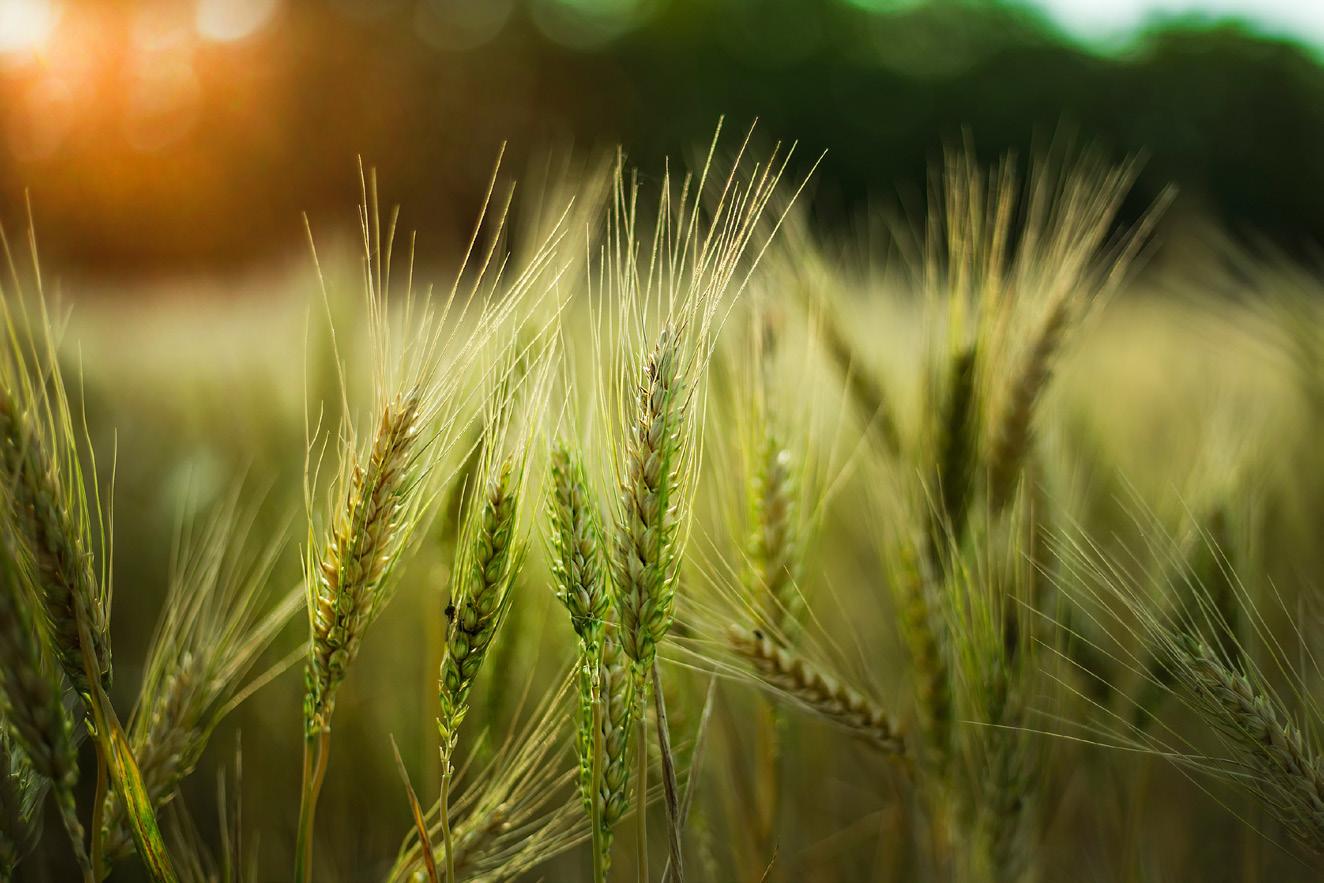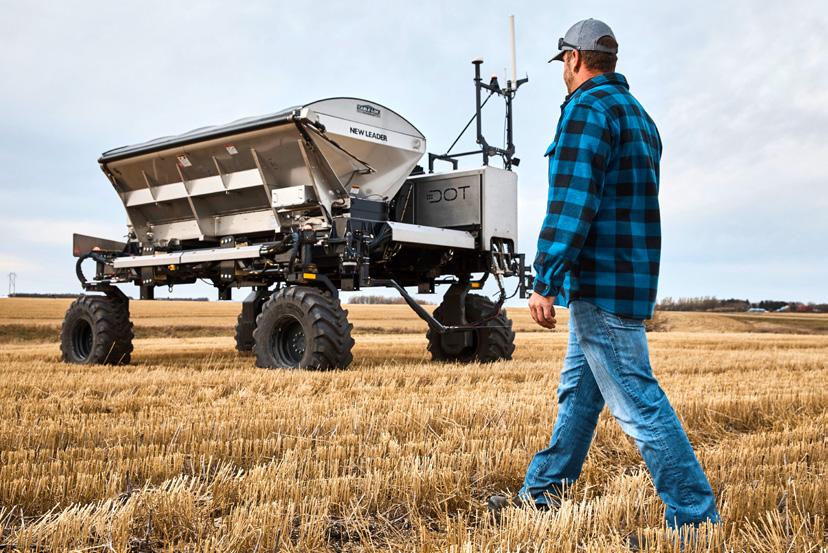
12 minute read
Soil Health Practices Revive Salinity Areas Regenerating Dead Zones

By Lura Roti for South Dakota Soil Health Coalition
Advertisement
White desert is how Frederick farmer, Don Nickelson, used to describe the saline patches on his land. “Nothing would grow there,” says the crop and cattle producer.
Hitchcock farmer, Scott Hamilton understands. Saline patches began showing up on his land in the 1990s. “If nothing will grow, not even (the weed) kochia, you know the land is in pretty tough shape.”
Although their approaches vary, both farmers discovered by implementing soil health practices, they were able to restore life to these former dead zones.
GEOLOGICAL ROOTS
Although landscape, soil type and climate may differ, the root of salinity issues on the land today stem from a common source that dates back to geology 65 to 145 million years ago, explains Cheryl Reese, South Dakota State University Senior Lecturer in the Department of Agronomy, Horticulture and Plant Science. “Most of the interior of the United States, from Texas to North Dakota - including South Dakota – was covered by a shallow, in-land, sea.” She explains, shale a type of sedimentary rock, was deposited at the bottom of this sea for millions of years. “The shale contains salts because it was deposited in a marine environment,” Reese says.
What remains today of this prehistoric sea are those salty shale deposits. The salts in this deposit are highly soluble in water. As the groundwater, water tables rise, due to increased precipitation, salts from this old marine deposit can seep to the soil surface and form white patches on the surface of fields and pastures, often referred to as saline seeps.
The location of a saline seep depends on a number of factors. These factors include how close the shale deposit is to the soil’s surface and how the water moves under the surface of the land. For example, if water percolating through the soil meets an impermeable soil horizon (layer) then water will be forced to flow along this border and potentially form a saline seep on the side of a hill.
LET MOTHER NATURE BE YOUR GUIDE
Sometimes the solution is right in front of you. This was the case for Scott Hamilton. For years, he’d been trying to get crops to grow on some saline patches. But instead of progress, the patches increased in size. Then, one day he looked across the road. Just a few yards away, on pastureland, he noticed quite a few forages growing.
“I thought, why am I fighting this? If plants are growing on that side of the road, why aren’t they growing on this side of the road.”
He realized, that instead of working to get specific crops to grow, he would experiment with a variety of forages to see what would grow in saline soils. “In native prairie, there are up to 300 different species of plants in one spot,” he says. “So, if one plant can’t grow, another one does. That is what I wanted – to put together a blend that is diverse enough to work all the time.”
Working with Millborn Seeds he began trying different blends and ratios until they came up with a diverse blend that worked: tall wheatgrass, AC Saltlander green
wheatgrass, Garrison creeping foxtail, intermediate wheat grass, and salinity max alfalfa.
In fact, the blend works so well, the company named it “The Hamilton.”
“Neighbors would stop and ask me what I was doing. I explained it to them and told them to call Millborn and tell them you want The Hamilton,” he says.
Today, instead of trying to get corn or soybeans to grow, Hamilton raises about 3 to 3.5 tons of forage per acre for his cattle.
“By not fighting nature, I am not spending money on those areas,” Hamilton says. “Sure, if I try and convert it back to crop production, it would probably work for a little while, but it would go back to saline after a while. Since I can’t farm the saline or salt spots most of the time anyway. Why fight it?”
Contact your local seed dealer or technical representative to create a mix customized for your area, management needs and goals.
BACKED BY SCIENCE
Growing a diverse mix of salt tolerant perennial grasses on saline areas is a proven solution, explains Reese.
“It goes back to plant roots and transpiration (water movement through the plant),” she says. “The roots of perennial grasses go down very deep and can potentially lower the ground water table which is the source of the salts coming to the surface when the ground is not covered with vegetation.”
She adds, the longer there is a living root on soils susceptible to saline issues, the better. “That is why planting cover crops after winter wheat or spring wheat is a good idea. It provides a source of organic acids and carbon for the soil microbial population and may potentially keep the water table lower.”
LET THE COWS DO THE WORK
After wracking his brain to try and fix the “white deserts” on his land, crop and cattle producer Don Nickelson decided to put his cattle to work for him.
Four years ago, he began bale grazing the saline patches on his land. An idea that came to him after attending SDSHC Soil Health School.
“I had limited time and limited resources. But I learned, keeping things covered is one of the principles of soil health. This ground was uncovered. It was too wet in the spring to do anything with it. And come summer, it was cracked and looked like a white desert.”
He stacked bales of hay close together - only 10 to 12-feet apart. “Having livestock, I knew a lot of things grow in barn lots once you pull the cows. I knew the cows would be standing around trampling the hay and manure into the ground. I knew something would grow without me having to do too much work.”
Nickelson was right. Within a season, seeds brought in with the bales began to grow. “Some people think of it as weeds growing. I only call it a weed if it is competing with something else,” he says. “I think of it like a scab. It looks kind of ugly, but that’s how healing starts.”
Along the edges of the saline patches, he began no-till drilling some salt tolerant grasses, like Garrison creeping foxtail. “I am amazed how much it has changed in the last few years. They are not 100 percent. And it never will be my highest producing areas of the field. I will always treat it as forage grass and utilize it for my livestock.”
He likens the process of converting white deserts to lush pasture to rescuing a calf during calving season. “It’s like when you save a calf that otherwise would have died – that ground was essentially dead – and I was able to save it by getting some plants growing on it.”
To learn more about how soil health practices can improve your land and connect with soil health technicians or producers in your area willing to mentor, visit www.sdsoilhealthcoalition.org.
WHAT’S THE DIFFERENCE BETWEEN A SALINE PATCH AND AN ALKALINE PATCH?
Nothing. Although in the past, areas where salts are at the surface have been commonly referred to as alkaline patches, according to Cheryl Reese, some folks use these two descriptors interchangeably.
However, the South Dakota State University Senior Lecturer in the Department of Agronomy, Horticulture and Plant Science says there is a difference between the types of salts in the soil. The terms used are saline and / or sodic’ soils.
“Saline means salt concentrations, in general, are too high. If a landowner requests a soil test for salinity, total calcium, magnesium and sodiumbased salts are measured. A separate test is completed to determine sodium presence.”
WHY IS THIS IMPORTANT?
Because high salt concentration (salinity) prevents seed germination for most common row crops.
Sodic soils or soils with high sodium salts add another problem. Soils high in sodium are prone to dispersion at the surface; the surface of the soil looks like concrete and is completed sealed up Reese explains. “Once a soil surface is dispersed, erosion problems occur during precipitation events. The results are tons of soil are lost, leading to degradation of the land and silting in of local streams and rivers.”

PHOTO COURTESY OF SDSU

Cheryl Reese, South Dakota State University Senior Lecturer in the Department of Agronomy, Horticulture and Plant Science (far left).

PHOTO COURTESY OF USDA-NRCS SD

Frederick crop and cattle producer, Don Nickelson, put his cattle to work helping him repair saline patches on his land. Four years ago, he began bale grazing the saline patches. An idea that came to him after attending SDSHC Soil Health School.
After wracking his brain to try and fix the “white deserts” on his land, crop and cattle producer Don Nickelson decided to put his cattle to work for him. Four years ago, he began bale grazing the saline patches on his land. An idea that came to him after attending SDSHC Soil Health School. This is a photo of a former white desert. Using native prairie as a guide, Hitchcock farmer, Scott Hamilton worked with a grass seed company to develop a blend of perennial grasses that would thrive on saline patches. This photo shows the land the first year he worked to get a perennial grass blend to establish. Using native prairie as a guide, Hitchcock farmer, Scott Hamilton worked with a grass seed company to develop a blend of perennial grasses that would thrive on saline patches. Today, what was once unproductive cropland, is now yielding more than 3 tons of forage each year for his cattle to graze.



THE HAMILTON MIX
Tall Wheatgrass .................... 25%
AC Saltlander Wheatgrass ...... 20%
Garrison Creeping Foxtail ....... 20% Intermediate Wheatgrass ....... 20%
SalinityMax™ Alfalfa ............... 15% These amounts are based on percentage of full seeding rate and are included as an example. Contact your local seed dealer or technical representative to create a mix customized for your area, management needs and goals.
Visit www.sdsoybean.org and complete our Farming Practices/Soil Health Survey for the chance to win a $250 VISA GIFT CARD!”

Helping people Helping people help the land. help the land.

The Natural Resources Conservation Service (NRCS) helps American farmers, ranchers, and forest landowners make conservation work for them. Through the system of more than 300 practices we promote, conservation planning helps people to improve production, reduce input costs, and conserve natural resources for the future. We also provide financial resources through the Farm Bill to help with the cost of getting conservation on the ground. The Natural Resources Conservation Service (NRCS) helps American farmers, ranchers, and forest landowners make conservation work for them. Through the system of more than 300 practices we promote, conservation planning helps people to improve production, reduce input costs, and conserve natural resources for the future. We also provide financial resources through the Farm Bill to help with the cost of getting conservation on the ground.
Giving advice & solutions Giving advice & solutions We provide free, one-on-one, personalized advice on the best solutions to meet the unique conservation and business goals of those who grow our nation’s food and fiber. We provide free, one-on-one, personalized advice on the best solutions to meet the unique conservation and business goals of those who grow our nation’s food and fiber. Providing support backed by science & research Providing support backed by science & research We generate, manage, and share the data, the research and the proven standards that enable partners and policymakers to make decisions informed by objective, reliable science. We generate, manage, and share the data, the research and the proven standards that enable partners and policymakers to make decisions informed by objective, reliable science.
Keeping working lands working Keeping working lands working Farmers are the backbone of America. We help people to make investments in their operations and local communities, boost rural economies, increase competitiveness of American agriculture, and improve the health of our air, water, and soil. Farmers are the backbone of America. We help people to make investments in their operations and local communities, boost rural economies, increase competitiveness of American agriculture, and improve the health of our air, water, and soil.



USDA-NRCS Farm Bill Programs USDA-NRCS Farm Bill Programs Manage - Opportunities to mitigate risk on your operation. Manage - Opportunities to mitigate risk on your operation.
• • Conservation Stewardship Program Grassland Conservation Initiative Conservation Stewardship Program Grassland Conservation Initiative
Conserve - Opportunities to implement conservation on your operation. Conserve - Opportunities to implement conservation on your operation.
• • • • • • • • • • • • Agricultural Conservation Easement Program (ACEP) Conservation Innovation Grants (CIG) Conservation Stewardship Program (CSP) Environmental Quality Incentives Program (EQIP) Regional Conservation Partnership Program (RCPP) Voluntary Public Access and Habitat Incentive Program (VPA-HIP) Agricultural Conservation Easement Program (ACEP) Conservation Innovation Grants (CIG) Conservation Stewardship Program (CSP) Environmental Quality Incentives Program (EQIP) Regional Conservation Partnership Program (RCPP) Voluntary Public Access and Habitat Incentive Program (VPA-HIP) Learn more at: farmers.gov Learn more at: farmers.gov Contact NRCS South Dakota: http://bit.ly/ContactNRCSSD Contact NRCS South Dakota: http://bit.ly/ContactNRCSSD Find your local USDA Service Center at: farmers.gov/service-locator Find your local USDA Service Center at: farmers.gov/service-locator


www.sd.nrcs.usda.gov 200 Fourth Street SW, Room 203, Huron, SD 57350 • (605) 352-1200 USDA is an equal opportunity provider, employer and lender. www.sd.nrcs.usda.gov 200 Fourth Street SW, Room 203, Huron, SD 57350 • (605) 352-1200 USDA is an equal opportunity provider, employer and lender.










